Bowling King Hack / Cheats - Obtenez de l'argent illimité et des jetons dans Bowling King APP
Bowling King Hack / Cheats - Obtenez de l'argent illimité et des jetons dans Bowling King APP
Ace Fishing: Wild Catch - No Tension Huge Damage iOS Hack [w / Liens de téléchargement!]
Ace Fishing: Wild Catch - No Tension Huge Damage iOS Hack [w / Liens de téléchargement!]


Ace Fishing: Wild Catch - No Tension Huge Damage iOS Hack [w / Liens de téléchargement!]
Ace Fishing EP 79 - Isafloraur d'Islandechannle pour les jeux, les astuces, les astuces et des astuces
Ace Fishing: Wild Catch - No Tension Huge Damage iOS Hack [w / Liens de téléchargement!]
Bonjour les gars
cette fois je vous montre comment faire pour que ce hack fonctionne of Mods is:
* Damage
il est plus facile à attraper avec une canne ou un moulinet normal (Rare Fish dépend toujours de l'attrait que vous utilisez et de ce qui vous stimule de le faire)
Like And Subscribe
PECHE ACE: CAPTURE SAUVAGE * HACK 2020 IOS SEULEMENT PAS DE JAILBREAK 1000
Different types of observers supported by modern browsers?
Different types of observers supported by modern browsers?
Before diving deeper into the observers family supported by modern browsers, lets try to understand what is observer in general?
What is Observer?
Observer is a programme which watches or notices something. Observers can be helpful to watch certain activities happening in the browser and respond accordingly. Observers are similar to dogs, watching certain activities and alerting us if something unusual happens. And its our responsibility to take an action once we are alerted by dogs for certain activities.

Similarly, there are different activities going on in the browser that can be watched and based on the type of an activity, we can take some actions. For eg. we can observe, if a video is displayed within the view port and enable autoplay, if child element has been added or removed from the parent DOM element, if the size/dimensions of a box element has changed and so on.
I have included four different types of observers supported by modern browsers.
- Intersection Observer
- Mutation Observer
- Resize Observer
- Performance Observer
- Intersection Observer :-
It is used to observer intersection between two html DOM elements. It is useful to watch an element in your DOM when it enters or leaves the visible viewport. Some of the use cases of Intersection Observer are described below
- Lazy-loading images or other resources when an element is visible within the viewport.
- Identifying visibility of an advertisements and calculating ad revenues.
- Implementing “Infinite Scrolling” websites (eg. forbes) when user scrolls down the page so that they don’t have to navigate through different pages.
- Loading and autoplaying, videos or animations when an element is within the viewport.
Browser support :- Currently, firefox and chrome supports Intersection observer but we can find polyfills for older browsers
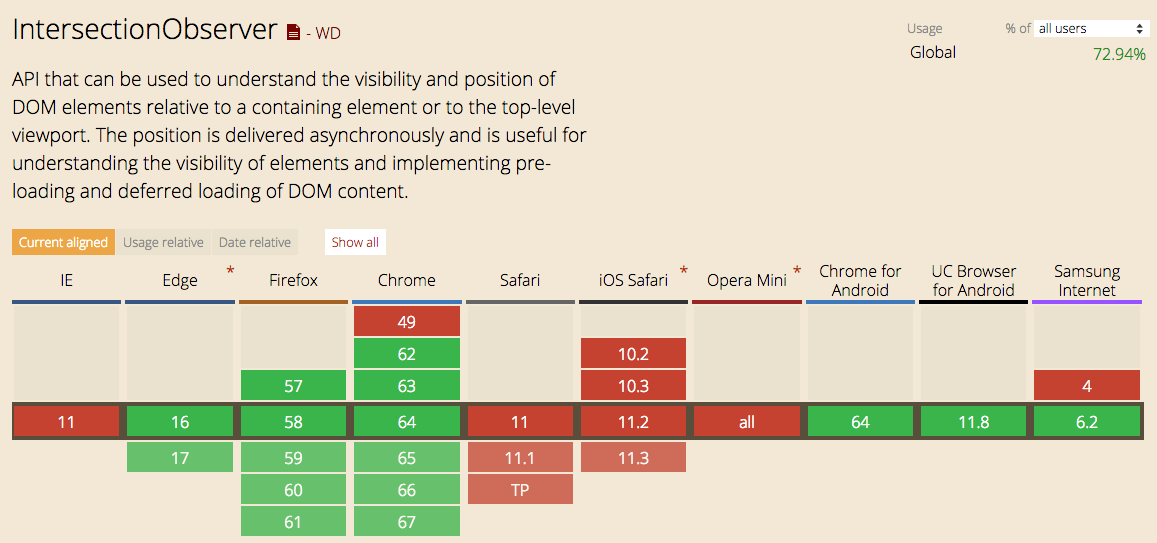
Using IntersectionObserver api mainly requires three steps
a) Creating Observer
b) Defining target object to observe
c) Defining callback handler
Threshold of [0.3] means, when target element is 30% visible within the element specified by root element, invoke the handler function. It means handler/callback function is invoked whenever element is visible by 30%, 50%, 80% and 100%.
b) Defining target object to observe :-
We can define multiple target objects to observe. As mentioned in the example before, a dog should know what to observe before alerting everyone.
Any target element can be observed, simply by calling .observe(target) method of the respective observer.
c) Defining callback handler :-
This is basically an action to take when a dog starts alerting, if something unusual happens. Callback handler is fired whenever, target element is intersected with the root element by threshold values.
I have prepared a demo which uses IntersectionObserver to change the color of the target box when it is visible within the visible area as user scrolls up.
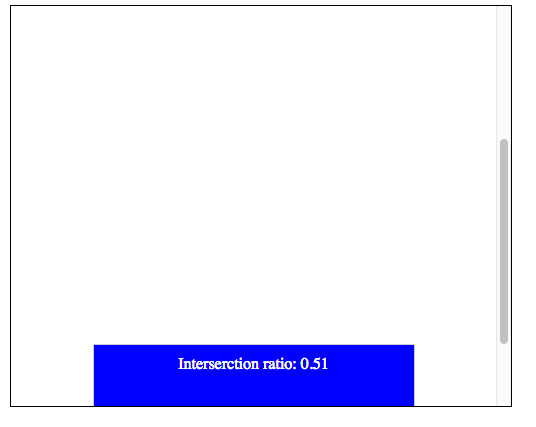
References: Demo , Intersection Observer Api
2. Mutation Observer :-
Mutation observers are used to observe changes in the DOM elements. It is useful to to observe changes such as addition or removal of child nodes in a parent node, changes in the value of attributes or data content etc. Before MutationObserver, DOM change events were handled by Mutation Events such as DOMAttrModified, DOMAttributeNameChanged, DOMNodeInserted.
Mutation observer is designed as a replacement for Mutation Events defined in the DOM3 events specification. The practical reasons to avoid the mutation events are performance issues and cross-browser support.
Probably the biggest audience for this new api are the people building JS frameworks, mainly to solve problems and create interactions they could not have done previously, or at least not with reasonable performance. Another use case would be a situation where you are using frameworks that manipulate the DOM and need to react to these modifications efficiently ( and without setTimeout hacks).
Browser Support :- It has pretty good support across different browsers.

In general, implementation of MutationObserver requires three steps
a) Creating Observer :-
It can be created, simply by calling its constructor and passing handler function and configuration options. We have an option to specify, what kind of changes do we want to track or observe.
childList: true, means observe changes related to child nodes, attributes: true means observe attribute change, characterData: true means observe changes in target element’s data content.
b) Defining target object to observe :-
observer.observe(…) method accepts target element which should be observed.
c) Defining callback handler :-
Depending upon the configuration used during observer creation process, callback function is executed whenever changes occurs in the target element. Callback function is fired with mutation records object which contains the type of mutation occurred in the target element.
I have prepared a demo that fires mutation observers’s callback handler, whenever new child node is added or removed along with attribute change.
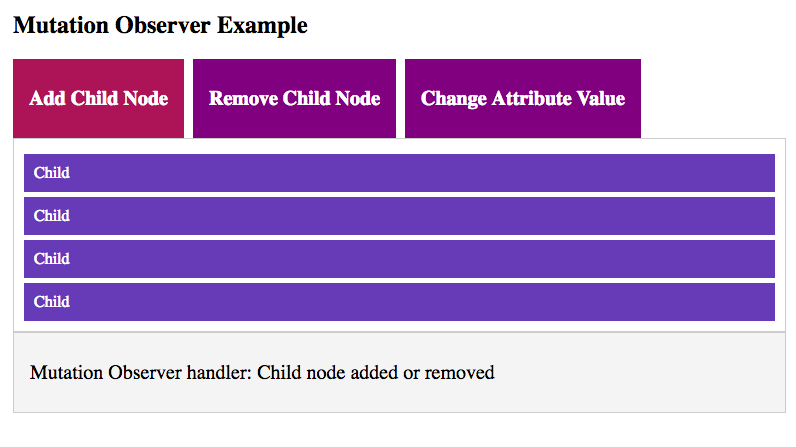
References: Demo, Mutation Observer Api
4. Performance Observer :-
It is used to observe the Performance Timeline and be notified of new performance entries as they are recorded by the browser. It can be used to measure certain performance metrices both in browser and nodejs applications. In browser we can access observer using Window object as window.PerformanceObserver and in nodejs application we have to require perf_hooks to get performance object. Eg.const { performance } = require(‘perf_hooks’); It can be useful in following cases
- Measure processing time between request and response. (In browser)
- Calculate duration while retrieving data from database. (In nodejs app)
- Abstract precise timing information using Paint Timing Api such as time for first paint or first content-ful paint.
- Access performance metrics using User Timing API, Navigation Timing API, Network Information API, Resource Timing API, Paint Timing API
Implementation of PerformanceObserver requires three steps
a) Creating Observer :-
It can be created, simply by calling its constructor and passing handler function.
b) Defining target object to observe :-
observer.observe(..) method accepts valid set of entry types that can be observed. These entry types may belong to various performance api such as user timing or navigation timing api. Valid entryType values are: "mark” [USER-TIMING], "measure" [USER-TIMING], "navigation" [NAVIGATION-TIMING-2], "resource" [RESOURCE-TIMING].
c) Defining callback handler :-
Callback handler is fired whenever observed event is used in the application. For eg. it can be used to mark the instant and measure the duration from start to end instant.
Feel free to play around with a simple demo which uses PerformanceObserver api. When a button is clicked by a user, it will mark the instant as start and end and measure the duration the after 3000ms. Output can be viewed in console.
References: Demo , Irina Shestak: Storytelling With Performance Observers -JSConf.Asia 2018, Performance Observer Api , NodeJS perf_hooks api
3.Resize Observer :-
Resize Observer allows us to watch changes in content rectangle size (width, height)of a DOM elements and react accordingly. It is like document.onresize() or window.resize() events for elements. It is useful when element changes their size without resizing the main window. For example, appending new children, setting element’s display property to none or similar actions can change the size of an element, its siblings or ancestors. It only watches content box. Some of the behaviour of resize observers are described below
- observation will fire when watched Element is inserted/removed from DOM.
- observation will fire when watched Element display gets set to none.
- observations do not fire for non-replaced inline Elements.
- observations will not be triggered by CSS transforms.
- observation will fire when observation starts if Element has display, and Element’s size is not 0,0.
Resize observer notifies about the dimensions of content box as shown in the figure below
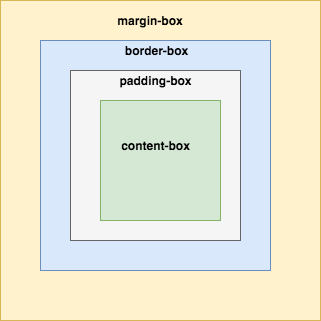
Browser Support :- Currently, it is not supported by most of the browsers except chrome ≥ 64.
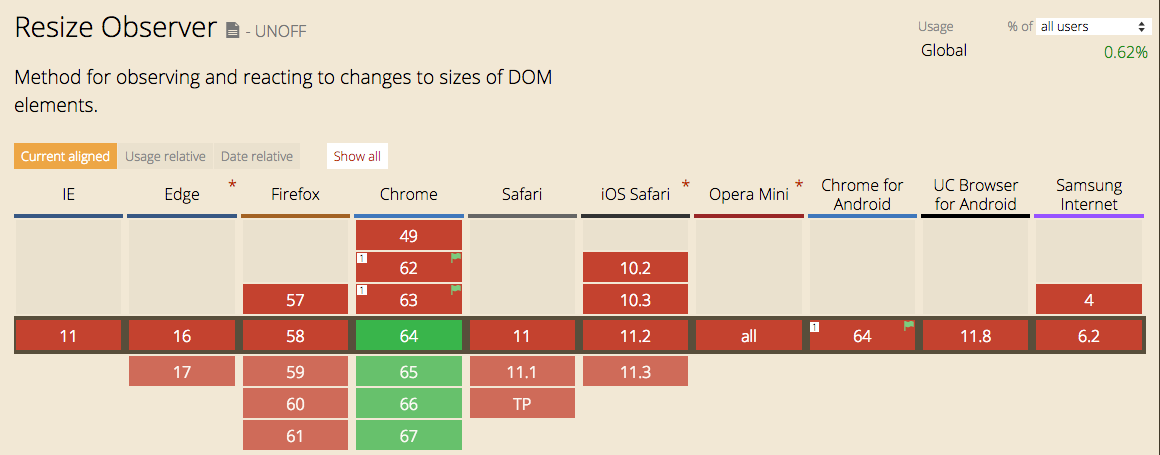
Observer’s api can be used in three steps as other observers
a) Creating Observer :-
It can be created, simply by calling its constructor and passing handler function.
b) Defining target object to observe :-
Define target object whose change in size should be observed.
c) Defining callback handler :-
References: Resize Observer Usage
Please let me know if you have any thoughts/suggestions/improvements regarding these observers.